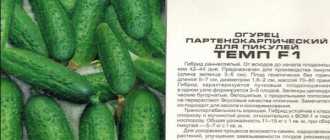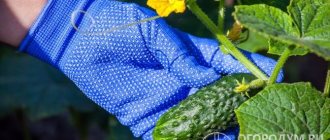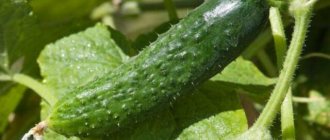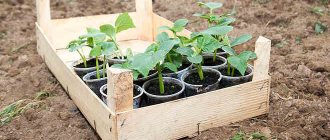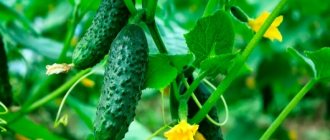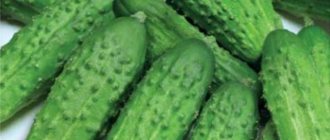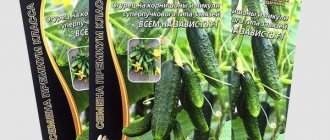History of the variety's creation
This hybrid is the fruit of selection by specialists from the Dutch company Seminis. When creating this variety, breeders from the Netherlands sought to create an early-ripening variety that can easily withstand transportation over long distances without losing marketability and taste, and also have high shelf life. The created hybrid has all these advantages, and also has an excellent taste; the harvest can be harvested early. Therefore, the Masha f1 cucumber quickly became popular among farmers in many countries around the world.
The best cucumber varieties!
• Early cucumbers GERMAN F1 • Greenhouse hybrid EMERALD STREAM F1 • Late ripening cucumbers PHOENIX
Russian gardeners who grow cucumbers for sale, as well as those summer residents who grow vegetables for personal needs, also paid attention to this hybrid. The cucumber Masha f1 was included in the State Register of Russia at the beginning of this century, zoned for cultivation in the central regions, the Volga region, and the southern regions.
Cucumbers Masha: variety description
Masha f1 cucumbers are recommended to be grown in greenhouses or greenhouses, since the variety is very thermophilic and does not tolerate temperature fluctuations. Therefore, cucumber of the Masha variety can be grown in open ground only in the south of Russia.
This hybrid belongs to the determinant type. The formation of side shoots is average. The foliage is wrinkled, small in size, and its color is emerald.
Cucumbers Masha photo
The hybrid is parthenocarpic and therefore does not require pollinating insects. Only female type flowers are formed on the shoots. There is no need to pinch the shoots, since the last thing to appear on the shoot is a brush with ovaries.
Side stems are formed in medium quantities, so there is no need to form lashes.
Hybrid Masha is ultra-early - from the moment the sprouts appear to the fruits ripening, it takes a little more than a month.
Cucumber yield Masha F1
The flowers are collected in bunches; up to 7 ovaries can be formed simultaneously in the internodes. Therefore, the hybrid is a high-yielding variety; the yield of Masha cucumbers per 1 m2 is usually up to 11 kg.
Gherkins are cylindrical in shape, with a dark emerald color of dense skin, on which light short stripes are visible. The skin shows light pubescence, as well as large tubercles with small spines.
Video about the cucumber variety Masha
The pulp is sweet, tender, crispy, and has no bitterness even if the ripe cucumbers are not removed from the vines on time.
The length of ripe gherkins reaches 10-11 cm, and their diameter is about 3.5 cm. The weight of ripe gherkins is about 95 g. Usually, these cucumbers are picked when their length is 8-9 cm, and new ovaries appear more actively, as a result The productivity of vegetable plants increases. The main positive feature of the hybrid is approximately the same size of ripe fruits.
The best varieties of cucumbers!
• High-yielding hybrid BERENDEY F1 • GINGA F1 • Cucumbers DIRECTOR F1
It is not recommended to allow the fruits to outgrow - in this case their taste will deteriorate.
The harvested crop tolerates transportation well and does not lose its taste. Cucumbers are versatile - they can be eaten fresh, as well as canned and pickled.
Hybrid Masha f1 is highly resistant to most diseases that affect other varieties of cucumbers.
MASHA cucumbers: care and cultivation
Planting and further cultivation of cucumbers of this variety does not differ from similar procedures for other varieties of cucumbers.
They can be grown by seedlings or without seedlings. When planting Masha f1 seeds for seedlings at home, you should prepare peat cups and a nutrient substrate. Seeds are planted in the first ten days of April, it is better not more than 2 plants in one cup, since grown cucumber seedlings do not tolerate picking and replanting well - in this case, the delicate roots of this vegetable plant are often injured.
Cucumber Masha F1 photo
Cucumber seedlings are transferred to a permanent location no earlier than mid-May, and the seedlings must have at least 2-3 permanent leaves.
Masha cucumber seeds are planted in open ground at the end of May, and no more than 4 plants should be placed per 1 m2.
Photos of Masha cucumbers
Further care for Masha cucumbers consists of regular watering, loosening the soil around the vegetable crop, removing weeds, and applying regular fertilizing.
When growing cucumber Masha f1 in a greenhouse, the vines need to be tied to trellises or supports - this will make it easier to care for the cucumbers and collect the ripening fruits.
Planting seeds in the ground
Planting times depend on the area. The soil should warm up sufficiently. This usually happens no earlier than the end of May.
Seeds are sown to a depth of 1.5–2 cm. You can add a handful of humus, 2 tsp. to each sowing hole. urea mixed with earth.
Beds with cucumbers should be covered with film before emergence.
If you are going to tie up plants and they will grow vertically, 1 sq. m. you can plant 3 cucumbers. If the bushes spread along the ground, you can sow up to 5 seeds.
When planting seeds in open ground, you need to choose a place:
- with sufficient sunlight;
- without strong winds or drafts;
- with fertile land.
The soil should be loose, well permeable to water and air. For planting, you should not choose acidic soil or an area with close groundwater.
It is best to choose a place where they grew before:
- tomatoes;
- cabbage;
- potato;
- onion;
- legumes
You should not plant cucumbers after squash, beets, melons, zucchini, and pumpkins.
Advantages and disadvantages of the cucumber variety Masha
Experts include the main advantages of this hybrid variety:
- cucumber Masha f1 belongs to the ultra-early ripening varieties;
- ripe greens have an excellent presentation;
- this hybrid belongs to the parthenocarpic type; only female flowers are formed on the vines;
- high yield of this variety;
- fruiting is friendly;
- greens - gherkin type;
- It is recommended to harvest at the gherkin stage;
- excellent taste of ripe fruits;
- high resistance to major diseases;
- The harvested crop tolerates transportation well over long distances without losing its presentation and taste.
Cucumber Masha F1 video
But this hybrid also has a number of disadvantages that you should be aware of:
- the skin is too thick, which not everyone likes;
- ripe greens do not have a pronounced odor;
- gherkins can outgrow, losing their taste;
- Harvesting must be done daily.
But Masha f1 cucumbers have much more advantages, which should be remembered by summer residents who choose new varieties of cucumbers to plant in their garden.
Cucumber Masha F1 reviews from those who planted
This hybrid is very popular among many summer residents in Russia. Some of the reviews left on the Masha f1 hybrid forum are given below:
Maria, 42 years old: I and my family like gherkin-type cucumbers for their excellent taste. Therefore, last season I decided to plant Masha f1 cucumber in my garden. And she did not regret her decision - the hybrid turned out to be high-yielding and early ripening, and also did not require special care. The harvest ripened smoothly, and as a result there was enough for both food and canning.
Olga, 52 years old: I have been growing the Masha f1 hybrid for several years now. I liked these cucumbers for their amazing early ripeness and smooth ripening of the fruits. The main disadvantage of this hybrid is that overgrown cucumbers lose their taste, so cucumbers should not be allowed to outgrow.
Nina, 55 years old: I regularly plant a couple of beds in my garden with gherkin cucumbers of different varieties. Last season, Masha f1 cucumbers were planted in a greenhouse; according to the description, they produce a harvest approximately 38-40 days after the sprouts appear. And that’s roughly what happened - after 1.5 months I was already harvesting gherkins. I noticed that you need to collect the fruits regularly, in this case new flowers immediately appear on the shoots and fruits are set. We live in the country, so this was not a problem. As a result, the harvest was even slightly larger than stated in the annotation. For me, the only drawback of the variety is that the seed material cannot be collected, since the cucumber is a hybrid, so every year you have to buy seeds in the store.
Summer residents who love gherkin cucumbers should pay attention to the Masha f1 hybrid, which can be grown in greenhouses or greenhouses. This hybrid variety of cucumbers is resistant to diseases, ripens very early, and the harvest ripens smoothly. All these positive qualities of the variety have already been appreciated by those vegetable growers who have been growing Masha f1 cucumbers in their garden for several years now.
You can leave reviews about Masha F1 cucumbers on our gardening portal and share your experience of growing this variety with other summer residents and gardeners.
Care
Mashenka f1 does not need particularly complex and intricate agricultural technology. It is enough to water the plantings on time, periodically feed the cucumber and cleanly weed the beds to remove weeds.
Watering
The variety requires a lot of moisture. Mashenka is watered, based on the description, every 3 days, on especially hot days - every 2 days. Cucumber prefers water left in the sun, heated to 24°-25°. Watering is done in the evening, by drip at the root, so as not to burn the leaves.
Garter and bush formation
Mashenka f1 is formed into one stem, which needs to be blinded up to the 5th leaf. Tying is carried out as soon as the cucumber grows 10-15 cm. The side shoots of the variety develop poorly. In the greenhouse, they need to be removed immediately after the first cucumber. The top can be pinched.
Top dressing
Feed the cucumber once every 10 days. Organic (diluted manure) and nitrogen-phosphorus (superphosphate) fertilizers are best suited for Mashenka - they need to be alternated. It is especially important, according to the description, to fertilize during the period of flowering and fruit set. The variety is fertilized in the morning or evening, applying fertilizer at the root.
Hilling
For the first time, the cucumber is spudded after the sprouts have stretched 7-10 cm. They are covered almost entirely, leaving only the top leaf. All subsequent hillings of Mashenka f1 are carried out on 1/3 of the plant. The variety is hilled during periods of frost, or, conversely, significant drought.
Cucumber Masha F1: description and characteristics from the manufacturer
UNIQUE, ULTRA-EARLY, SALTED HYBRID! RESISTANT TO LOW TEMPERATURES. A very early gherkin hybrid, distinguished by excellent taste, without bitterness. The fruits have a rich green color and beautiful appearance, so they are suitable for growing not only for personal consumption, but also for sale. The fruits are consumed fresh, added to salads, and they are also very tasty in pickled and canned form.
These cucumbers are not only tasty, but also healthy, because they consist of 95% water, which contains fiber, sugar, potassium, calcium, magnesium, phosphorus, iodine, vitamins B, C. In a word, not a product, but some vitamins that are good for the body.
Characteristics of Masha f1 cucumbers:
- For open ground
- For closed ground
- Planting pattern: 50x40 cm
- Fruit length: 8-12 cm
- Fruit diameter: 3-3.5 cm
- Fruit weight: 90-110 g
- Ideal for canning
- Used fresh
Recently searched:
Diseases and pests
If you do not follow the rules of care, cucumber bushes become vulnerable to many diseases.
Cucumber mosaic
The fruits and foliage of Masha cucumbers are deformed, and specks appear on the skin. Fundazol is used for treatment.
White rot
Foliage, stems and fruits are covered with a white coating, reminiscent of fluff. Remove the affected parts, the rest of the bush should be sprayed with a solution (10 liters of water, 2 g of copper sulfate and 10 g of urea).
Powdery mildew
The leaves are covered with brown spots, which are covered with a purple coating on top. This leads to drying and falling. The fungus will help overcome Skor, Topaz.
Anthracnose
The fruits of Masha cucumbers become bitter and begin to rot. The leaves are drying. The following fungicides are suitable for treatment: Fundazol, Previkur.
Aphid
A small insect infects the lower part of the leaf. The leaf blade turns yellow and rots. For treatment you can purchase Inta-vir, Actellik.
Slug
The pest eats the foliage of Masha cucumbers. For destruction, not only prevention is important, but also treatment with a drug such as Metaldehyde.
Thrips
An insect eating a leaf blade causes its deformation. The leaf resembles a bowl. A decoction of yarrow or the store-bought drug Fitoverm will help.
Spider mite
The leaves of Masha cucumbers are deformed and covered with a thin cobweb. Use an infusion of celandine, dandelion or a solution of laundry soap.



